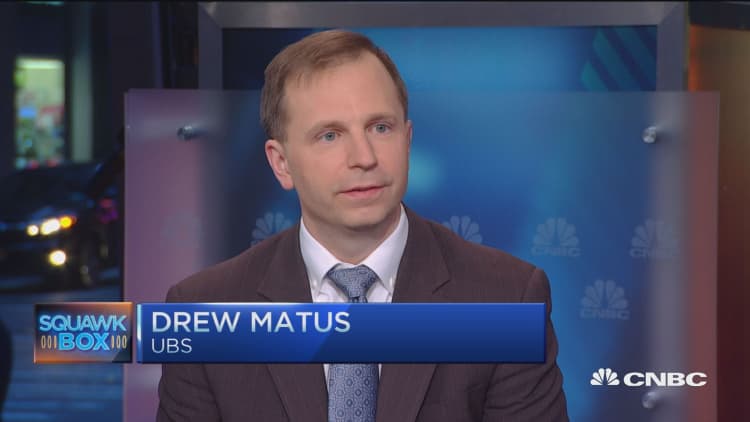
Just weeks after Wall Street was preparing for the impending apocalypse comes talk that now would be a good time to raise interest rates.
There's virtually no chance of that happening — literally zero, according to the CME's FedTracker tool. The Fed, at its meeting next week, instead is likely to explain in its closely followed code that it won't be hiking its rate target as it believes current financial conditions warrant a pause.
However, a small but growing chorus on the Street believes the Fed is missing an opportunity. They contend that the volatility that hit markets from mid-2015 through the early part of February has past. Employment gains have continued, energy prices have bounced and the has jumped more than 7 percent during the period.
Read More Suddenly, the market sees growth—and rate hikes
So, the reasoning goes, the Fed should follow through on its expressed intentions to raise rates four times this year, starting with the Federal Open Market Committee's meeting next Tuesday and Wednesday.
"All things considered, if the FOMC was starting with a blank slate next week, we suspect that officials would vote to raise interest rates," Capital Economics said in a note to clients this week. "But it is not and the Janet Yellen-led FOMC has repeatedly shown itself to be unusually hesitant in making policy changes and very reluctant to upset financial markets."
The Fed finds itself in an interesting bind. While it is looking if not to tighten at least to begin normalizing interest rate policy, its global counterparts are loosening. European Central Bank President Mario Draghi announced fresh easing measures Thursday that at first lifted equity markets, which then fell after he said the latest measures cutting rates and stepping up quantitative easing likely would be it for now.
But the ECB is fighting a different battle, trying to stave off deflation while the Fed's critics worry about inflation getting out of control.
Tom Porcelli, chief U.S. economist at RBC Capital Markets, also has been a voice calling for the Fed to hike now.
"The improvement in most economic variables (not to mention the uptick in core PCE inflation) we think adds validity to our contention that a no hike at the March FOMC would be inconsistent with the mantra of data dependency," he said in a recent note. "We get that when it comes to monetary policy, concerns about market stability and global headwinds have trumped the resilience in the U.S. economy. But even here, there has been some considerable improvement over recent weeks."
Read More Why the market doesn't believe the Fed anymore
Upset in the market earlier in the year had taken expectations for a rate hike this year down to zero. At one point, traders in fed funds futures weren't fully pricing in a hike until early 2018. That has changed in recent days.
The first rate hike is completely priced in for December. Traders expect the funds rate at the March meeting to be little changed from its current level of 0.36 percent, then rising to 0.46 percent by the June meeting. The CME's FedWatch tool considers that June level to translate into a 42 percent chance of an FOMC move. The September meeting is the first with a better than 50 percent probability — 57 percent, with traders anticipating a 0.54 percent funds rate.
As things stand for the full year, the market and the Fed remain far apart in their respective rate projections. FOMC members anticipate a 1.4 percent funds rate; the market puts it closer to 0.63 percent.
While the Fed calls itself "data dependent" regarding its decision making (as Porcelli alluded), it seems every bit market dependent as well. That means the Fed is less likely to move more quickly, even though some market experts believe policymakers could justify the move. Fed doves have indicated a preference to let inflation overheat a bit before putting on the brakes.
"I would hike next week, but they're not going to," said Jim Paulsen, chief market strategist at Wells Capital Management. "Sentiment has really changed pretty dramatically in the last 30 to 40 days. The last two jobs reports and everything in between has been pretty good."
Like others in the hike-now camp, Paulsen said signs of inflation are growing even though worker paychecks may not show it.
Core inflation (excluding food and energy) as measured by the personal consumption expenditures index — the Fed's preferred measure — was up 1.7 percent in its latest reading, near the Fed's 2 percent target.
From a practical standpoint, Paulsen said that while he doesn't expect the Fed to hike rates, he is hoping for language in the post-FOMC meeting statement indicating that the day is drawing nearer.
"The underlying core costs acceleration is pretty striking to me. It certainly has come right on schedule with full employment and looks very much Phillips Curve-like," Paulsen said, referring to the popular measure used to determine where rates should be based on conditions. "Not that there's runaway inflation anywhere, but a zero interest rate structure seems kind of absurd."






